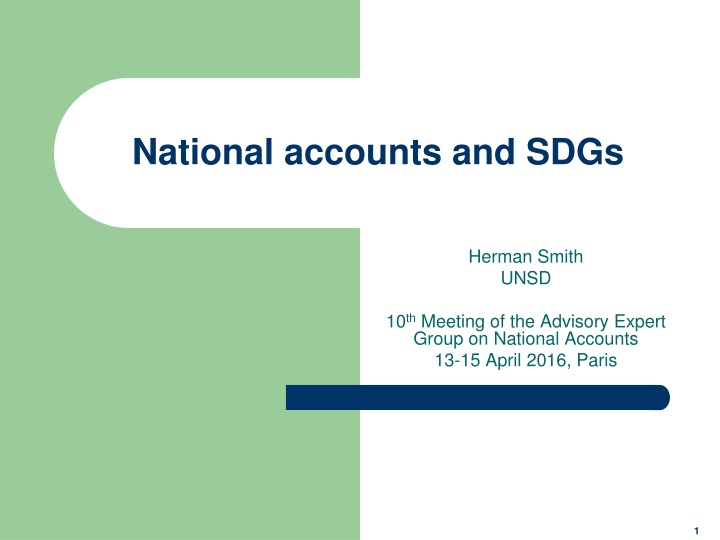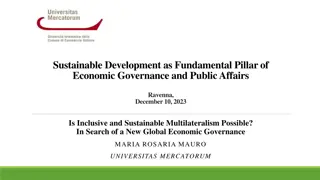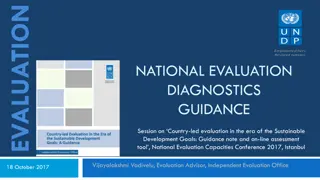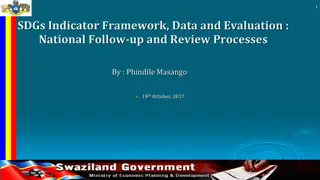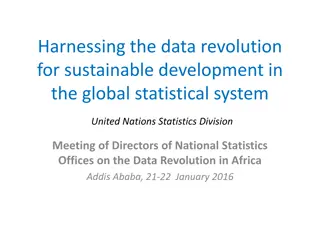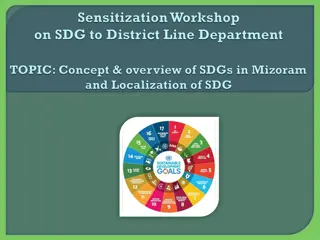Advancing National Accounts for Sustainable Development Goals
Sustainable Development Goals (SDGs) provide a framework for global action towards sustainable development. The IAEG-SDGs is working on a program to classify and establish methodologies for tracking indicators related to national accounts, essential for monitoring progress towards the SDGs. Through inclusive processes, global indicators have been identified with a focus on data availability and methodological development. The program aims to address data gaps, establish baselines, and enhance capacity-building efforts for effective monitoring and reporting on SDGs.
Uploaded on Oct 04, 2024 | 1 Views
Download Presentation

Please find below an Image/Link to download the presentation.
The content on the website is provided AS IS for your information and personal use only. It may not be sold, licensed, or shared on other websites without obtaining consent from the author.If you encounter any issues during the download, it is possible that the publisher has removed the file from their server.
You are allowed to download the files provided on this website for personal or commercial use, subject to the condition that they are used lawfully. All files are the property of their respective owners.
The content on the website is provided AS IS for your information and personal use only. It may not be sold, licensed, or shared on other websites without obtaining consent from the author.
E N D
Presentation Transcript
National accounts and SDGs Herman Smith UNSD 10thMeeting of the Advisory Expert Group on National Accounts 13-15 April 2016, Paris 1
Introduction Background IAEG-SDGs Programme of work IAEG-SDGs Work plan for 2016-2017 Highlights: Metadata and global reporting structure SDGs Indicators related national accounts data 2
Background Sustainable Development Goals (SDGs) provide the framework for the 2030 Agenda for Sustainable Development They consist of 17 Goals and 169 Targets agreed by the international community to guide common actions for sustainable development Statistical community mandated to find a list of indicators to monitor progress towards the Goals 3
Background The IAEG-SDGs - through an inclusive and transparency process - identified a list of global indicators In March 2016, the UNSC agreed as a practical starting point with the proposed global indicator framework subject to future technical refinement 230 indicators of which about 46 relate to national accounts 4
IAEG-SDGs Programme of work Classify indicators into 3 tiers, based on their level of methodological development and overall data availability Tier 1: The indicator is conceptually clear and standards are available. Data is regularly produced by countries, and there is current data available Tier 2: Indicator conceptually clear, standards available and data not regularly produced by countries Tier 3: Indicator for which standards need still to be developed and data not regularly produced by countries 5
IAEG-SDGs Programme of work Establish adequate methodology for Tier 3 indicators, in consultation with specialized agencies and relevant experts Discuss available data sources and methodology for improved coverage of Tier 2 indicators Explore new data sources and data collection technologies, including through partnerships with civil society, private sector and academia Regularly review methodologies for indicators 6
IAEG-SDGs Programme of work Establish baseline for tracking indicators Address question of periodicity of reporting Review and discuss data gaps and related capacity-building priorities, and transmit results to High Level Group Agree on format of compilation and dissemination of metadata on global indicators 7
IAEG-SDGs Work plan for 2016-2017 a) Agree on global reporting mechanism, identifying entities responsible for individual indicators to be provided to the Secretariat b) Establish tier system for indicators Establish work plan to further develop Tier 3 indicators d) Establish procedures for methodological review of indicators and approval mechanisms e) Review data availability for Tiers 1 and 2 c) 8
Global Reporting Structure The 47th UNSC agreed that: the compilation of global indicators will be based to the greatest extent possible on comparable and standardized national official statistics, provided by countries to the international statistical systems; and when other sources and methodologies are used, these will be reviewed and agreed by national statistical authorities and presented in a transparent manner International agencies receive data from countries through well-established and further improved reporting mechanisms, support increased adoption and compliance with internationally agreed standards at the national level, work for strengthening national statistical capacity and improving reporting mechanisms. 9
Global Reporting Structure Data flow from national to global level 10
Metadata provide information on the definitions, rationale, concepts and sources of the data for the global SDG indicators promote international comparable data provide a reference point and guidance for countries 11
Standardized Metadata Template Goals and Targets addressed Definition and method of computation Rational and interpretation Disaggregation Sources and data collection Comments and limitations Current data availability / indicator tier Responsible entities Data collection and data release calendar 1. 2. 3. 4. 5. 6. 7. 8. 9. 10. Treatment of missing values 11. Sources of differences between global and national figures 12. Regional and global estimates & data collection for global monitoring 13. References 12
SNA and SDGs SNA related data are used in a number ( 46) of SDGs indicators Examples: 1.5.2 Direct disaster economic loss in relation to global gross domestic product (GDP) 8.1.1 Annual growth rate of real GDP per capita 8.3.1 Proportion of informal employment in non- agriculture employment, by sex 9.5.1 Research and development expenditure as a proportion of GDP 10.5.1 Financial Soundness Indicators 17.4.1 Debt service as a proportion of exports of goods and services 13
Conclusions Important to be engaged in the discussion to ensure that the metadata for indicators more closely relates to economic statistics and national accounts are statistically sound 14
Thank you! 15
